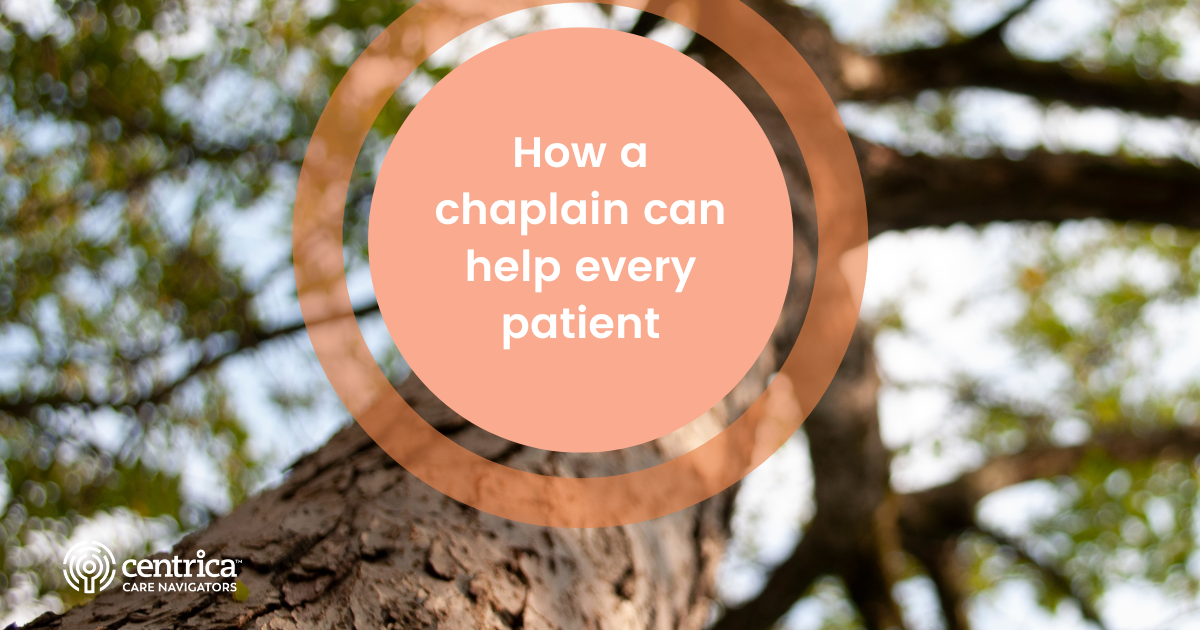For many people, the last weeks and months of life aren’t only focused on receiving compassionate care for their illness. They’re also about reinforcing connections with friends and family, and about what they personally believe — their spirituality.
“People can pray on their own, but they also need someone to guide them with the big issues,” says Blessed Madugba, a chaplain at Centrica Care Navigators.
Like doctors and other members of the interdisciplinary group (IDG) that meets with every patient who receives service, he works with patients approaching the end of their lives. His focus is on their spirituality and emotional well-being.
One of the roles of chaplains is to facilitate dignified departure at the end of life. They help patients in managing their fears about death and dying, providing emotional and spiritual support that brings comfort to both the dying and their loved ones, so that the patient can die peacefully with dignity.
“Doctors and nurses help manage physical pain; chaplains manage spiritual pain, spiritual distress, and spiritual struggles,” says Madugba. “Some people may not be religious, but they may still have other emotional issues and struggles. Even those patients who are doing fine spiritually and emotionally still need continuous spiritual nourishment, enrichment, and encouragement from the chaplains for optimal spiritual health and emotional well-being.”
The chaplain’s role
Chaplain Janet Thomas-Kobes says the role of a chaplain with an end-of-life patient is simply “to be,” and to get to know patients on a personal level. While everyone in an IDG listens to patients and caregivers and works hard to build relationships, doctors are focused on managing symptoms. Social workers help with the paperwork, and connecting people to useful resources. Chaplains deal with something that can be a little challenging to define.
All of Centrica Care Navigators’ chaplains make it clear that when they visit a patient, it is never their goal to try and convert that person to a particular faith. Chaplain differs from other spiritual roles like minister or priest, because the chaplain’s focus is on doing what the patient wants, instead of delivering a message or helping to direct a congregant’s understanding of a religious text.
What a patient wants could be prayer or readings from the Bible (Psalms 23 and 103 are popular). It could be a specific ritual in the patient’s own faith, and chaplains may get in touch with someone from that religious tradition to make sure the ritual is carried out appropriately. Or a patient might simply be looking for someone to talk to.
Chaplain William Harris, who worked with the Centrica Care Navigators team for several years, said he could always make a connection by talking about food, since everyone has a favorite meal or restaurant.
More seriously, patients may bring up unresolved issues with family members, or feelings of guilt or shame, that they want to resolve before their death.
“They may have hurt other people, or other people have hurt them,” Madugba says. “People ask, ‘Have I been forgiven?” or, ‘Am I right with God?’”
A day in the life
For chaplains — and for every member of the IDG — the workday starts by checking emails and records for updates on their patients. Everyone takes careful notes of what happened during their meetings with a patient, including the patient’s physical condition and what they talked about. That gives chaplains an idea of how to plan their day: who needs immediate attention and who is on the schedule for their regular weekly or monthly meeting.
If it’s the first time a patient is meeting with members of the IDG, chaplains talk with patients, getting to know them and determining where they are spiritually.
“It has everything to do with going within, and finding that piece of them they cannot see,” Thomas-Kobes says. “Helping them ‘attach’ to who they are helps them feel less anxious.”
Harris said when he meets with patients, he reviews positive, meaningful moments with them, to help them take their mind off the pain and tension they’re often feeling.
“It’s not easy when anyone hears from a doctor that there’s nothing more they can do for a patient with regards to aggressive curative measures and treatments,” Madugba says. “That person begins their journey into the ‘hospice lane.’ The chaplains come alongside to accompany them in their journey, to provide spiritual and emotional strength and support for them and their loved ones.”
Having a guide
Chaplains say patients also turn to them almost for permission, for an opportunity to talk about lingering issues in their lives, or even for someone to say it’s all right to die. Though people can pray on their own, chaplains say there’s something different about having a spiritual guide for more involved rituals, or simply to lend a friendly ear.
“(People) don’t know how to be still — that’s just human nature,” Thomas-Kobes says. “They need someone to come in and say, ‘Why don’t you listen to the quiet?’ Surrounding us, there’s 24/7 noise. Who listens to the birds anymore unless they’re dying?”




